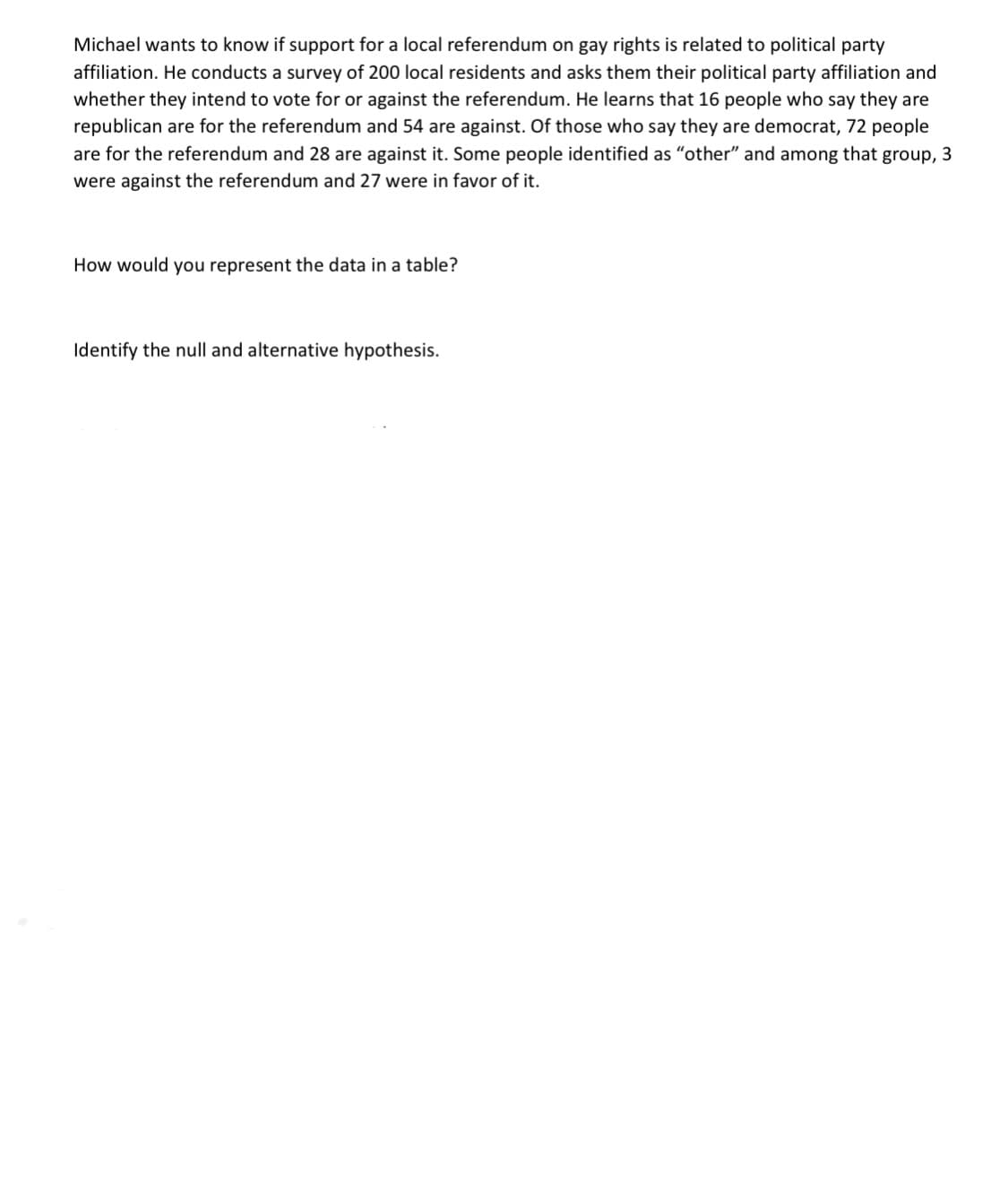Michael wants to know if support for a local referendum on gay rights is related to political party affiliation. He conducts a survey of 200 local residents and asks them their political party affiliation and whether they intend to vote for or against the referendum. He learns that 16 people who say they are republican are for the referendum and 54 are against. Of those who say they are democrat, 72 people are for the referendum and 28 are against it. Some people identified as "other" and among that group, 3 were against the referendum and 27 were in favor of it. How would you represent the data in a table? Identify the null and alternative hypothesis.
Michael wants to know if support for a local referendum on gay rights is related to political party affiliation. He conducts a survey of 200 local residents and asks them their political party affiliation and whether they intend to vote for or against the referendum. He learns that 16 people who say they are republican are for the referendum and 54 are against. Of those who say they are democrat, 72 people are for the referendum and 28 are against it. Some people identified as "other" and among that group, 3 were against the referendum and 27 were in favor of it. How would you represent the data in a table? Identify the null and alternative hypothesis.
Glencoe Algebra 1, Student Edition, 9780079039897, 0079039898, 2018
18th Edition
ISBN:9780079039897
Author:Carter
Publisher:Carter
Chapter10: Statistics
Section10.6: Summarizing Categorical Data
Problem 13CYU
Related questions
Topic Video
Question

Transcribed Image Text:Michael wants to know if support for a local referendum on gay rights is related to political party
affiliation. He conducts a survey of 200 local residents and asks them their political party affiliation and
whether they intend to vote for or against the referendum. He learns that 16 people who say they are
republican are for the referendum and 54 are against. Of those who say they are democrat, 72 people
are for the referendum and 28 are against it. Some people identified as "other" and among that group, 3
were against the referendum and 27 were in favor of it.
How would you represent the data in a table?
Identify the null and alternative hypothesis.
Expert Solution
This question has been solved!
Explore an expertly crafted, step-by-step solution for a thorough understanding of key concepts.
This is a popular solution!
Trending now
This is a popular solution!
Step by step
Solved in 2 steps with 1 images

Follow-up Questions
Read through expert solutions to related follow-up questions below.
Follow-up Question
Michael wants to know if support for a local referendum on gay rights is related to political party affiliation. He conducts a survey of 200 local residents and asks them their political party affiliation and whether they intend to vote for or against the referendum. He learns that 16 people who say they are republican are for the referendum and 54 are against. Of those who say they are democrat, 72 people are for the referendum and 28 are against it. Some people identified as “other” and among that group, 3 were against the referendum and 27 were in favor of it.
1. Conduct the appropriate analysis with α=.05.
2. What should Michael conclude?
Solution
Knowledge Booster
Learn more about
Need a deep-dive on the concept behind this application? Look no further. Learn more about this topic, statistics and related others by exploring similar questions and additional content below.Recommended textbooks for you

Glencoe Algebra 1, Student Edition, 9780079039897…
Algebra
ISBN:
9780079039897
Author:
Carter
Publisher:
McGraw Hill

Glencoe Algebra 1, Student Edition, 9780079039897…
Algebra
ISBN:
9780079039897
Author:
Carter
Publisher:
McGraw Hill